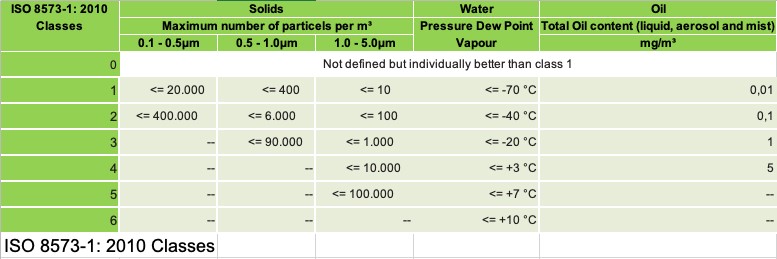Food manufacturers are required to follow the principles of HACCP in order to comply with food legislation. Therefore, a risk analysis must be carried out on the entire manufacturing and packaging process.
Compressed air very often is missed as a potential source of contamination because it is only seen as a utility. To be fully compliant with food legislation, the compressed air system must be included as part of the HACCP analysis. Anywhere where compressed air is used, it needs to be classified as a Critical Control Point and needs to be subject to the ISO 8573-1 compressed air quality recommendations as seen in the tables below.

Compressed Air in the food Industry will be categorized as one of the following:
- Air that comes into direct contact with the food (Contact).
- Air that will never come into contact with the food (Non-Contact).
- Where the HACCP analysis shows a potential risk of the Non-Contact air indirectly contacting food or entering the food manufacturing area, then the air is defined as Non-Contact High Risk.
Here are the definitions of these categories:
Contact
Air that comes into direct contact with ingredients and/ or finished products, packaging materials, storage vessels or the manufacturing/ packaging machinery.
Non-Contact
Air that will never come into contact with ingredients, finished products, packaging materials, storage vessels or the manufacturing/ packaging machinery.
Non-Contact High Risk
Air that is not supposed to come into contact with ingredients, finished products, packaging materials, storage vessels or the manufacturing/ packaging machinery, but may do so (for example: compressed air that exhausts to atmosphere through a pneumatic cylinder in the packaging machine might very well get into contact with the product) .

Particles
The purity requirements for particles are identical for Contact, Non Contact and Non Contact – High Risk. The same amount of particle filtration will be required for each classification.
Water
The purity requirements for water vapor are identical for both Contact & Non Contact – High Risk. This requires the installation of desiccant dryers which deliver a pressure dewpoint (PDP) of -40°Ctpd or below. This requirement is essential to combat the growth of micro-organisms as compressed air with a dewpoint of -26°Ctpd or better will inhibit microbiological growth. The purity requirements +3°Ctpd for Non-Contact will not inhibit microbiological growth (this pressure dewpoint is achieved with a refrigeration dryer).
Oil
The purity requirements for total oil (liquid, aerosol and mist) are effectively identical for Contact, Non-Contact and Non-Contact – High Risk with the same level of filtration required for each classification.

Figure 1 stationary measuring solutions for ISO 8573-1 monitoring
CS Instruments (Pty) ltd. has the right measuring solution to measure all these important parameters like dew point sensors, particle counters and residual oil content monitors. Continuous monitoring as well as portable measurements is possible for all parameters. Further to this CS Instruments (Pty) ltd. also offers compressed air quality audits according to ISO 8573-1 as a service to industries.

Figure 2 ISO 8573-1 trolley for air quality audits
CS Instruments can also offer the treatment solutions (dryers and filters) in order to reach the desired ISO 8573-1 compressed air quality classes.
Please don’t hesitate to contact us!

web www.cs-instruments.com/za
phone 021 557 5618
email info@cs-instruments.co.za








